Our approach
At Brooks, we believe climate change demands urgent and universal action. We live, work, and run as part of a global community. The planet is our home, and because more than 150 million people worldwide run outside, it’s critical we take care of it.
The Intergovernmental Panel on Climate Change (IPCC) and the leading climate scientists from across the globe agree that the world must take immediate, rapid, and large-scale actions to cut global emissions in half by 2030. We must also reach net-zero greenhouse gas (GHG) emissions by 2050 to limit global temperature rise to 1.5°C and avoid the catastrophic impacts of climate change.
We are taking a science-based approach to address climate change and aligning efforts across every level of our business to reduce GHG emissions, from raw materials to manufacturing processes, at every stage of our global supply chain.
Our climate action efforts are guided by two objectives:
| OBJECTIVE 1 Reduce greenhouse gas emissions in line with climate science | OBJECTIVE 2 Reach net-zero greenhouse gas emissions by 2040. |

- Reduce absolute Scope 1 & 2 greenhouse gas emissions 50% by 2030 and 90% by 2040 (from a 2021 baseline)
- Reduce Scope 3 greenhouse gas emissions 52% per unit of production by 2030 and 97% by 2040 (from a 2021 baseline)
Understanding Scope
Scope 1: GHG emissions generated directly from our offices, distribution centers, stores (e.g., use of natural gas) and vehicle fleets.
Scope 2: GHG emissions from the generation of purchased electricity used in our offices, distribution centers and stores.
Scope 3: Any indirect GHG emissions that occur across our entire value chain. This includes the materials used in our products, manufacturing of our gear, transportation and distribution, employee business travel and other categories of indirect emissions.
Using the best practices and guidance from the Science Based Targets initiative (SBTi), we have developed ambitious, near- and long-term Scope 1, 2, and 3 GHG emissions reduction goals that were approved to meet the SBTi Net-Zero Standard – meaning that our targets are in line with a 1.5°C trajectory – the most ambitious designation available through the SBTi – and consistent with the reduction required to keep global warming below 1.5°C.
Our footprint
A critical first step toward taking action to reduce GHG emissions is to understand the sources of our GHG emissions. We track and disclose our GHG emissions in line with the Greenhouse Gas Protocol, the leading greenhouse gas accounting standard for corporations.
Sources of our GHG emissions:
- Breakdown of Scope 1, 2, & 3 GHG emissions:
Scope 1: ~0.5%
Scope 2: ~0.5%
Scope 3: 99% - Breakdown of Scope 3 GHG emissions:
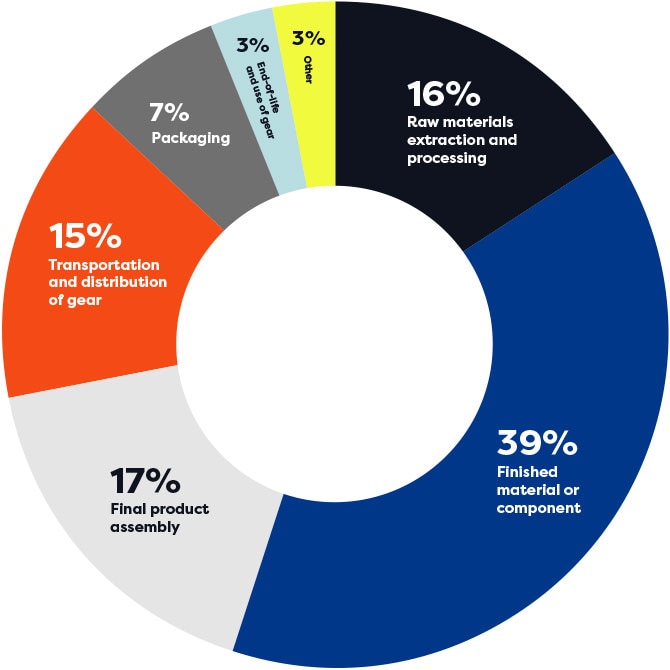
- 16% Raw materials extraction and processing
- 39% Finished material or component
- 17% Final product assembly
- 7% Packaging
- 15% Transportation and distribution of gear
- 3% End-of-life and use of gear
- 3% Other
Learn more about our latest annual GHG emissions inventory in our latest Corporate Responsibility Performance report.
Our climate roadmap
Using the insights from our GHG emissions inventory, we developed a climate roadmap that identifies strategies to reduce GHG emissions across our value chain. These strategies were developed through a series of workshops in collaboration with key stakeholders across our organization, including product design and development, sourcing, and distribution teams. Each strategy identified in the workshops was modeled to calculate their GHG emissions reduction potentials and provide us with clear paths to a reduction of our emissions and achievement of our science-based goals.
Key strategies in our approach to reducing GHG emissions:
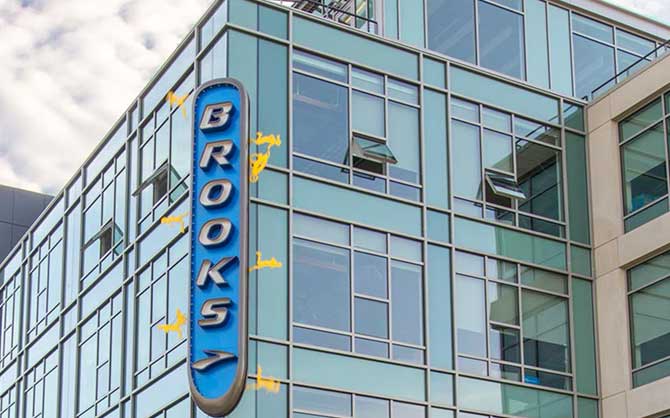
- Convert all Brooks global-operated facilities to 100% renewable energy
- Convert our leased vehicle fleet to low-emission vehicles
- Transition to renewable energy at Tier 1 (final assembly) and Tier 2 (material suppliers) factories, through on-site generation and renewable energy purchases
- Convert materials to recycled or low carbon intensity alternatives
- Maximize material usage and reduce manufacturing material waste
- Convert dyeing of materials in our product to low-impact processes
- Transition to circular product
- Reduce manufacturing waste and divert remaining waste from landfill and incineration
- Prioritize ocean shipments for inbound transport
- Procure low-emission maritime fuels through book-and-claim approach
- Limit air shipments for outbound transportation
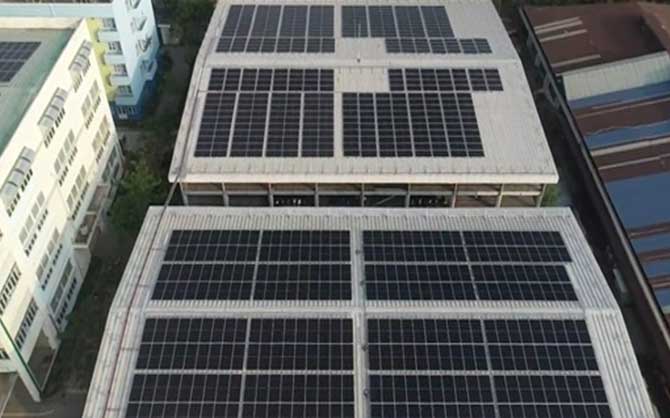
Learn more about some of these strategies in our latest Corporate Responsibility Performance report and visit our sustainable consumption page for strategies that also play a key role in our achieving GHG emissions reduction goals.
We continually evaluate our climate roadmap knowing that additional strategies will be necessary to achieve our science-based goals. In addition to analyzing our GHG emissions inventory, we also utilize Product Carbon Footprint (PCF) assessments to identify new opportunities to reduce GHG emissions and evolve our climate roadmap. Learn more about our PCF assessment of the Ghost 15.
Brooks Global Headquarters
Brooks HQ South has been operational since 2014 and is certified LEED Platinum, using 79% less energy than a typical office building. It achieves energy savings through its chilled beam water-based heating and cooling system and LED lighting systems. It is also the first commercially developed building to complete the City of Seattle’s Living Building Pilot Program by meeting and surpassing rigorous sustainability benchmarks during a 12-month period. Among other sustainable building goals, the program requires curbing energy and water usage by 75% and reusing 50% of captured rainwater, in contrast to an average office building.
Brooks HQ North has been operational since 2024. In accordance with Seattle’s Living Building Pilot Program, Brooks HQ North is designed to consume 25% less energy than the Seattle Energy Code baseline, which already serves as one of the most stringent codes in the country for new construction. It will achieve this energy savings through its heat recovery and heat pump-driven central plant and LED lighting systems. The building also includes one of the largest rainwater cisterns in Seattle at a capacity of over 267 thousand gallons. Rainwater will fulfill all of the building’s non-potable water demands.
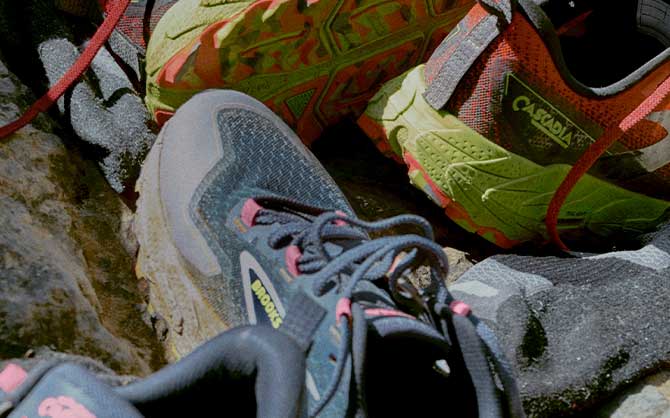
- Reach net-zero greenhouse gas emissions across the value chain by 2040
We recognize that the sooner the world can curb GHG emissions, the greater the chance of keeping global temperature below 1.5°C. That's why we've committed to achieving net-zero GHG emissions by 2040 — 10 years ahead of the Paris Agreement’s 2050 goal.
Partnerships and global action will be critical to achieving our ambitious climate goals. Therefore, in 2020, Brooks became a signatory of The Climate Pledge, cofounded by Amazon and Global Optimism. Brooks was the first athletic brand and among the first 40 companies in the world to sign the commitment to meet the Paris Agreement 10 years early.
Our path to net-zero
How we will achieve net-zero GHG emissions:
- Prioritize GHG emissions reductions in line with climate science to achieve our near-term and long-term science-based goals.
- Neutralize all residual GHG emissions through independently verified carbon credits.
As we move along our climate roadmap, we recognize that we will continue to be responsible for GHG emissions. To make an immediate impact, we compensate for some residual GHG emissions with carbon credits.
We started in 2021 with our highest-volume style – the Ghost 14 – as our first carbon neutral product. Our commitment is ongoing, so when each new version of the Ghost hits stores, we will continue to make the shoe carbon neutral. Starting with our Spring 2024 season, we expanded our carbon neutral styles to include all trail styles of footwear and apparel.
Carbon credits
Carbon credits come from projects that verifiably avoid, remove, or reduce GHG emissions from the atmosphere through actions like displacing fossil fuel energy with the development of renewables, restoring degraded land with new forest, and reducing fuel usage through clean cooking solutions.
How we choose carbon credit projects
Not all carbon credits are equal. We ensure quality by purchasing carbon credits from projects that are verified to leading international standards within the voluntary carbon credit market (e.g., Verra, Gold Standard, and the American Carbon Registry), which confirms that carbon credits are additional, permanent, quantifiable, and independently verified.
Additionally, we carefully selected our carbon offsetting partner, Climate Impact Partners, because they go the extra mile, undertaking additional due diligence beyond these standards to assess projects against a broader range of criteria that ensures we only work with the highest-quality projects.
Finally, we prioritize projects that align with climate science and deliver clear social and environmental impacts beyond reducing GHG emissions, such as improving air quality, health, and well-being for communities.
We currently prioritize purchasing carbon credits from projects that reduce GHG emissions or prevent them from entering the atmosphere in the first place, because we believe this has an immediate impact on climate change. Our long-term approach is to purchase carbon credits from projects that permanently remove and store GHG emissions from the atmosphere in alignment with the SBTi net-zero standard.
Carbon credits projects
In partnership with Climate Impact Partners, we select projects that meet our strict criteria and purchase enough carbon credits from these projects to compensate for the GHG emissions associated with each pair of carbon neutral styles we manufacture. Please visit our Voluntary Carbon Offset Disclosure document for more information on each of our hand-selected projects.
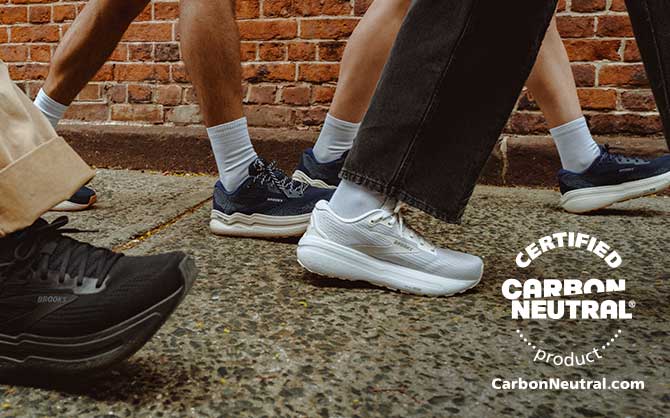
All of Brooks’ carbon neutral products are certified in accordance with the CarbonNeutral Protocol, the leading global framework for carbon neutrality. We do this to ensure that we are operating in line with the most up-to-date best practices of the voluntary carbon market.
Engaging in climate action:
- Signed Business Ambition for 1.5°C
- Signatory of The Climate Pledge
- We Are Still In signatory
- One of nine original signatories of coZEV to accelerate maritime shipping decarbonization
- Joined the Zero Emission Maritime Buyers Alliance (ZEMBA)







